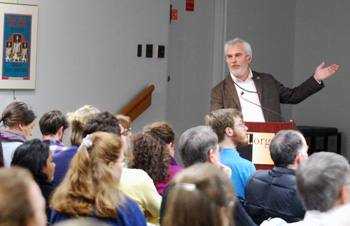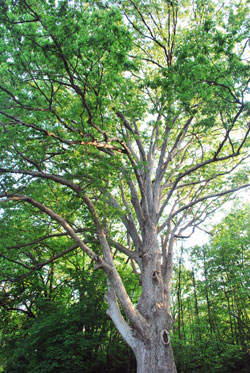Kingsley/Ashley area: Flurry of new street-tree planting, mostly redbud and serviceberry. [photo] I wouldn’t place any bets whether that particular row survives ‘121 Kingsley West‘condo construction.
Stories indexed with the term ‘urban forest’
Washington btw Ashley and Main
Crews are plucking tree in poor condition from a pit with giant claw. The replacement tree is a ginko. [photo] Downtown parking meter heads are bagged with white green fair hoods to keep people from parking on-street for tonight’s event, which starts at 6 p.m.
Tree Town OKs Urban Forestry Plan
The city’s first comprehensive plan for managing Ann Arbor’s urban forest has been given approval by the city council. Action came at the council’s June 2, 2014 meeting. The Ann Arbor park advisory commission had recommended adoption of the plan at its meeting on April 15, 2014. [.pdf of Urban & Community Forest Management Plan]
An urban forest is defined as all the trees, shrubs and woody vegetation growing along city streets, in public parks and on institutional and private property. In Ann Arbor, about 25% is on public property, with 75% on private property. Based on a U.S. Dept. of Agriculture Forest Service i-Tree Eco Analysis done in 2012, Ann Arbor’s urban forest has an estimated 1.45 million trees. It creates a … [Full Story]
Urban Forestry Plan Moves to Council
The city’s first comprehensive plan for managing Ann Arbor’s urban forest has been recommended for approval by the Ann Arbor park advisory commission at its April 15, 2014 meeting. [.pdf of Urban & Community Forest Management Plan]
An urban forest is defined as all the trees, shrubs and woody vegetation growing along city streets, in public parks and on institutional and private property. In Ann Arbor, about 25% is on public property, with 75% on private property. Based on a U.S. Dept. of Agriculture Forest Service i-Tree Eco Analysis done in 2012, Ann Arbor’s urban forest has an estimated 1.45 million trees. It creates a 33% tree canopy – the layer of leaves, branches and stems of trees that cover the ground when … [Full Story]
Dean Tree Fund Committee Changed
At its June 4, 2012 meeting, the Ann Arbor city council voted officially to eliminate the city council appointee to the Elizabeth Dean Tree Fund committee. The committee was established in 1975 to oversee the use of the investment earnings from a nearly $2 million bequest made to the city by Elizabeth Dean. According to a Nov. 10, 1974 Ann Arbor News article, the bequest was made in the early 1960s to “repair, maintain and replace trees on city property.” The principal amount remains intact.
The formal elimination of the city council committee member leaves the committee with seven voting members and one non-voting member – the city’s urban forestry & natural resources planning coordinator. The city’s description of the committee indicates … [Full Story]
Sustaining Ann Arbor’s Environmental Quality
Ann Arbor city staff and others involved in resource management – water, solid waste, the urban forest and natural areas – spoke to a crowd of about 100 people on Jan. 12 to highlight work being done to make the region more environmentally sustainable.

Matt Naud, Ann Arbor's environmental coordinator, moderated a panel discussion on resource management – the topic of the first in a series of four sustainability forums, all to be held at the Ann Arbor District Library. (Photos by the writer.)
It was the first of four public forums, and part of a broader sustainability initiative that started informally nearly two years ago, with a joint meeting of the city’s planning, environmental and energy commissions. The idea is to help shape decisions by looking at a triple bottom line: environmental quality, economic vitality, and social equity.
In early 2011, the city received a $95,000 grant from the Home Depot Foundation to fund a formal sustainability project. The project’s main goal is to review the city’s existing plans and organize them into a framework of goals, objectives and indicators that can guide future planning and policy. Other goals include improving access to the city’s plans and to the sustainability components of each plan, and to incorporate the concept of sustainability into city planning and future city plans.
In addition to city staff, this work has been guided by volunteers who serve on four city advisory commissions: Park, planning, energy and environmental. Many of those members attended the Jan. 12 forum, which was held at the downtown Ann Arbor District Library.
The topics of the forums reflect four general themes that have been identified to shape the sustainability framework: Resource management; land use and access; climate and energy; and community. The Jan. 12 panel on resource management was moderated by Matt Naud, the city’s environmental coordinator. Panelists included Laura Rubin, executive director of the Huron River Watershed Council (and a member of the city’s greenbelt advisory commission); Kerry Gray, the city’s urban forest and natural resource planning coordinator; Jason Tallant of the city’s natural area preservation program; Tom McMurtrie, Ann Arbor’s solid waste coordinator, who oversees the city’s recycling program; and Chris Graham, chair of the city’s environmental commission.
Dick Norton, chair of the University of Michigan urban and regional planning program, also participated by giving an overview of sustainability issues and challenges that local governments face. [The university has its own sustainability initiative, including broad goals announced by president Mary Sue Coleman last fall.]
The Jan. 12 forum also included opportunities for questions and comments from the audience. That commentary covered a wide range of topics, from concerns over Fuller Road Station and potential uses for the Library Lot, to suggestions for improving the city’s recycling and composting programs. Even the issue of Argo Dam was raised. The controversy over whether to remove the dam spiked in 2010, but abated after the city council didn’t vote on the question, thereby making a de facto decision to keep the dam in place.
Naud said he’s often joked that the only sure way to get 100 people to come to a meeting is to say the topic is a dam – but this forum had proven him wrong. The city is interested in hearing from residents, he said: What sustainability issues are important? How would people like to be engaged in these community discussions?
The forum was videotaped by AADL staff and will be posted on the library’s website. Additional background on the Ann Arbor sustainability initiative is on the city’s website. See also Chronicle coverage: “Building a Sustainable Ann Arbor,” and an update on the project given at the November 2011 park advisory commission meeting. [Full Story]
Action on Argo Headrace, Trails Near Fuller
Ann Arbor park advisory commission meeting (Aug. 16, 2011): During a three-hour meeting on Tuesday, park commissioners walked down several topical trails in what PAC chair Julie Grand aptly described as a “super-packed” agenda.

The view looking east down the dewatered Argo headrace, with the embankment on the right. The trail along the embankment to Broadway is closed, as the city prepares for major reconstruction of the headrace. (Photos by the writer.)
Commissioners approved a resolution recommending a change to the scope of work at the Argo headrace – a change that will add a new entrance to the soon-to-be-reconstructed waterway from Argo Pond to the Huron River. The modification to the project was linked to an offer from DTE to pay for a whitewater section that’s part of the overall project, which freed up city funds for the new entrance. A state permit needed to start the reconstruction is expected to be received by Aug. 23.
A second resolution introduced at Tuesday’s meeting urged the city council to incorporate design of a trail system – including the county’s Border to Border (B2B) trail – into the Fuller Road area in advance of building the proposed Fuller Road Station. Two members of the Washtenaw Bicycling & Walking Coalition were on hand with suggestions for where trails might be located to bypass the busy intersection of Fuller Road, Maiden Lane and East Medical Center Drive.
The topic of trails also emerged tangentially during a presentation by PAC vice chair John Lawter on dog parks. Some people walk their dogs off leash on park trails and in other park areas, violating Ann Arbor’s ordinance requiring dogs to be leashed. The exception is in the city’s two dog parks, on the north and south edges of town.
Lawter suggested that Ann Arbor might find other ways to let dogs off leash, either by creating another traditional dog park that’s more centrally located, or designating certain hours for dogs to be off leash in specific parks. PAC might form a subcommittee to explore options for a new dog park, and for how to increase enforcement of existing dog-control ordinances. Such an effort might uncover more data points like those Lawter provided in his presentation, which included the pounds of poo collected annually at Swift Run dog park.
Data collection has also been part of developing the city’s first urban forest management plan. Oliver Kiley of JJR, the consultant leading this project, updated the commission on the effort. Possible outcomes include a recommended maintenance plan, protections for mature trees, targets for new tree plantings, and proposals for relevant ordinances and zoning. The discussion among commissioners led to concerns over whether the city is prepared for something similar to the emerald ash borer – which decimated thousands of trees in the city over the past decade and chewed up the city’s forestry budget for several years.
The urban forest management plan will be among the 26 city plans in a sustainability framework being developed, focused on “triple-bottom line” goals of economic vitality, environmental quality and social equity. The commission was briefed on this project in preparation for a Sept. 27 joint meeting of the park, planning, energy and environmental commissions. The goal of that meeting is to start prioritizing goals from these existing city plans. [Full Story]
Environmental Indicators: Trees
Editor’s Note: This is the fourth in a series of Chronicle pieces on the environmental indicators used by the city of Ann Arbor in its State of Our Environment Report. The report is developed by the city’s Environmental Commission and designed as a citizen’s reference tool on environmental issues and as an atlas of the management strategies underway that are intended to conserve and protect our environment. The report is organized around 10 Environmental Goals developed by the Environmental Commission and adopted by city council in 2007.

This is one of Ann Arbor's more significant trees. Some readers will undoubtedly recognize it and will know its location, type, and age – which they're invited to leave in the comment section.
This month’s report is also an invitation to all readers to participate in the development of Ann Arbor’s first comprehensive Urban Forest Management Plan. A public workshop to help kick off the planning effort is being held on June 1, 2010 from 7-9 p.m. at Forsythe Middle School, 1655 Newport Road.
This spring has been exceptional with both beautiful weather and ample rain. The trees seemed to have noticed, with their early bud break in April and full canopies by mid-May. While we worried for those tender emerging leaves when the temperature dipped below freezing, the trees handled the dips in temperatures just fine and are now flourishing.
That’s good news because the city receives exceptional benefits from our trees. A recent analysis of the publicly managed trees (i.e., trees along streets and mowed areas of parks) estimated that they provide $4.6 million in benefits each year. When you factor in the cost for management, the city receives $2.68 in benefits for every $1 it spends on the municipal forestry program. We think that’s a pretty good rate of return.
What are these benefits and how were they calculated? [Full Story]



